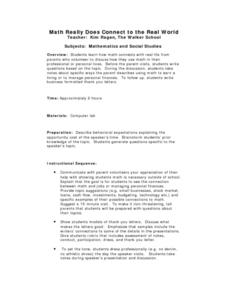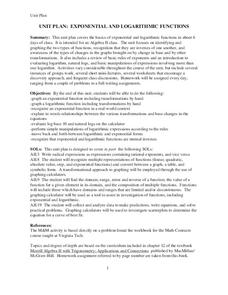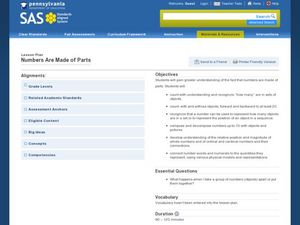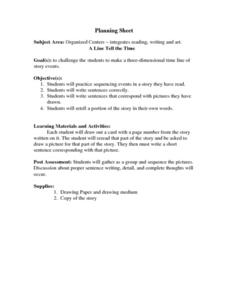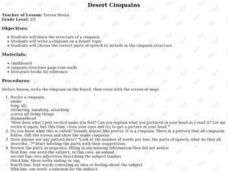Curated OER
Parts of a Cell Analogy
Students reinforce comprehension of the parts of a cell. Theyl synthesize this content knowledge in a descriptive paragraph writing assignment.
Curated OER
Vocabulary 15 Practice Quiz
Focus on some difficult vocabulary words that begin with f, g, and h. First, match the 10 vocabulary words to their definitions, and then decide which sentence each vocabulary word best completes. Example words include furtive,...
Curated OER
Beginning and Ending Consonants
Young readers explore consonant sounds. In this beginning phonics lesson, learners fill in a beginning/middle/end vertical column chart with the sounds they hear in the pictured object. Practice spelling CVC words.
Curated OER
Math Really Does Connect to the Real World
Learners listen to parent speakers who discuss how they use math in their professional or personal lives. They take notes and write business form thank you letters.
Curated OER
Meet Our Teachers
Learners of all ages interview, record, and photograph teachers and staff at their school. They organize the photo with a soundbite into a PowerPoint presentation. They transcribe the interview and write a response to it.
Curated OER
Reading Research!
Pupils investigate the life of an animal and how it responds to winter. The lesson plan's focus is on reading and research skills using pictures to assist in the understanding of the information presented.
Curated OER
Rosa Parks
Second graders discover who Rosa Parks was and the significance of her role in Black History. Students place events in Rosa Park's life in chronological order.
Curated OER
George Winter Lesson Plan 3
Bring language arts and U.S. history together in this lesson, which prompts middle and high schoolers to gather biographical information about Abraham Lincoln. They compare and contrast information written about his childhood and discuss...
Virginia Department of Education
Factoring for Zeros
Relate factors to zeros and x-intercepts. Scholars first graph quadratics in both standard and factored forms to see that they are the same. They go on to use the graphs to see the relationship between factors and x-intercepts.
Curated OER
The Progressive Era: Muckrakers Grade 8
As you explore an excerpt from Upton Sinclair's The Jungle with your class, discuss how his descriptions of the meat-packing industry caught the public's attention and helped to promote change in the Progressive Era.
Curated OER
Tense Buster
Pupils, after using the "Intermediate" selection of the Tense Buster software, recognize and practice using passive voice in their writing. As a result of this task, they correctly use five new vocabulary terms with passive voice in...
Virginia Tech
Unit Plan: Exponential and Logarithmic Functions
A six-day unit for algebra II on exponential and logarithmic functions builds upon Chapter 12 of Merrill Algebra II with Trigonometry; Applications and Connections. The text provides assistance in the depth of instruction...
Curated OER
Inductive and Deductive Reasoning
Students use logical arguments and inductive reasoning to make or disprove conjectures. After observing a teacher led demonstration, students discover that the deductive process narrows facts to a few possible conclusions. In groups,...
Pennsylvania Department of Education
Numbers Are Made of Parts
Children play with barnyard animal cards to practice composing and decomposing numbers. With their "secret number" of animal cards in a cup, they shake and spill them onto a barn story board, counting how many animals fall in the barn...
San Francisco Symphony
The Sound of Oklahoma's History
Learners will research what life in Oklahoma was like prior to and after the Oklahoma Land Run. They'll examine photographs and paintings that show Oklahoma before and after the land run, then they'll draw their own representations of...
Curated OER
Patterns Patterns Everywhere
Upper graders work with number patterns. In this pattern lesson, learners recognize and continue number patterns and find the rules. They do some as a class and complete an assessment.
BBC
Reception
A nice lesson on recognizing and counting from one to nine is here for you. In it, learners hold up number cards which reflect the number of monkeys who are left during a reading of the story, "How Many Monkey's Left?" A simple lesson...
Curated OER
Count on Me
Fourth graders use inductive reasoning to find algebraic patterns in geometric figures. They use technology (i.e., calculators, computers) and manipulatives to discover number patterns involving geometric concepts. They solve concrete...
Curated OER
Narrative Cartoons
Students create narrative cartoons based on the activities of the Peace Corps. In this narrative cartoons lesson plan, students create comic strips where they draw and write about various activities that the Peace Corps is involved in.
Curated OER
Following a Monster
Students follow tracks of a monster who has walked through their classroom to see what he has done. They discuss sequencing vocabulary before using computer software students sequence the monster's visit using a concept map. In a word...
Curated OER
Organized Centers
Students are challenged to make three-dimensional time lines of story events from stories they have read. They practice sequencing events and writing sentences correctly. In addition, they write sentences that correspond with pictures...
Curated OER
Cause And Effect
Fourth graders read the book Stellaluna and cite sentences that show cause and effect in the story. In this cause and effect lesson plan, 4th graders also write sentences that show cause and effect in their own lives.
Curated OER
Data Scavenger Hunt
Eighth graders discuss how data is collected and participate in data collection through a survey. They complete a scavenger hunt on the Internet to gain understanding of the data measures mean, median, mode, and range.
Curated OER
Desert Cinquains
Students use the cinquain structure and correct parts of speech to write a poem with a desert theme.



